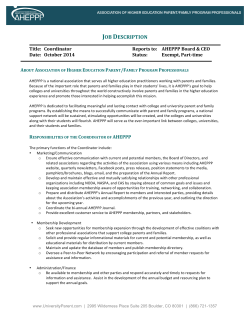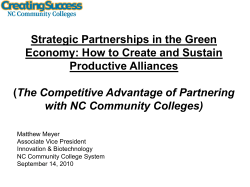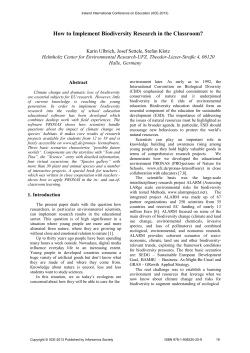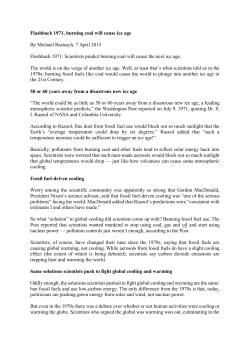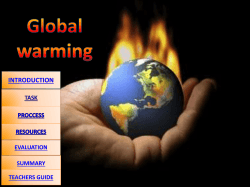
Face Earth`s Future - Association of American Colleges and
T I M O T H Y J . B R A L OW E R , P. G E O F F R E Y F E I S S , A N D C AT H R Y N A . M A N D U C A Preparing a New Generation of F E A T U R E D T O P I C Face Earth’s Future Earth system science must establish its place in college curricula HOW MUCH will global temperatures rise over the next century? How fast will ice sheets on Antarctica and Greenland melt and raise global sea level? Will rising temperature and acidification of the oceans extinguish corals and other endangered marine ecosystems? Will global warming cause hurricanes more powerful than Andrew and Katrina? What triggers the massive earthquakes that cause large tsunamis such as the devastating 2004 Indian Ocean event? These questions of habitability, sustainability, and survival are driving a surge of research in earth system science, a field that incorporates atmospheric science, earth science, ecology, and oceanography. Moreover, they are transforming the field from one that focused on the past to one that is increasingly forward-looking, aided by major advances in instrumentation and computational power. As the research interests and the focus of traditional earth scientists are transformed, so too must education in earth system science at colleges and universities across the country change. The required change involved not only the methods we use to teach this new science, but also the essential place of the earth sciences in the panoply of disciplines as traditionally ordered by our academic colleagues. With growing public and political awareness of the significant environmental problems facing the earth in the coming decades, and the realization that issues such as global warming require action on the part of individuals as well as governments, earth system science TIMOTHY J. BRALOWER is department head and professor of geosciences at the Pennsylvania State University, P. GEOFFREY FEISS is provost at the College of William and Mary, and CATHRYN A. MANDUCA is director of the Science Education Resource Center at Carleton College. 20 must establish its place in college curricula to ensure that a new generation of citizens and scientists is prepared to meet future challenges. To earth scientists, all of this is self-evident. But it is not always so within the broader communities of the academy. We hear, for example, that the twenty-first century will be the “Century of Biology.” Earth science courses, faculty, and departments are often the first casualties of financial exigency and budget insufficiency. Is it possible that in 2050 we will find ourselves wrestling with an earth system we only partially understand as human impacts tip us toward climate, ecosystem, and resource crises of literally life-threatening or apocalyptic dimensions? We posit that strong research in earth system science and equally strong investments in both teaching the earth sciences and training a new generation of earth system scientists are not optional but essential. The handwriting is on the wall: we have only one earth; we are engaged in a dangerous experiment that involves altering the dynamics of earth systems upon which we are wholly dependent; we do not fully understand how the system works, and we are only beginning to be able to predict our effect on that system. Global crises Without doubt, earth system science is the beneficiary of global misfortune. This science is vital to understanding crucial global threats in the coming century: shortages of water (potable and otherwise), declining availability of fossil fuels, coastal inundation, the literal collapse of ecosystems, and of course, global warming—to name the obvious. Global warming threatens to wreak havoc with global agriculture, with particularly strong impacts in tropical and subtropical regions that include a large portion of the developing world. The combination of scarce natural resources and population increase is not sustainable. Overpopulation, largely in LIBERAL EDUCATION SPRING 2008 Copyright© 2008 by the Association of American Colleges and Universities f Citizens and Scientists to Carleton College Copyright© 2008 by the Association of American Colleges and Universities T O P I C F E A T U R E D developing countries and especially in Africa and Southeast Asia, places people directly in harm’s way as towns and cities are built in areas prone to natural disasters. The 2007 report of the Intergovernmental Panel on Climate Change (IPCC) projects that, by 2080, one hundred million people will be affected each year by rising sea levels. These issues are not simply matters of scientific interest; they will fundamentally drive national and international politics in the twenty-first century. Consider a specific example. There is probably no greater threat to global stability and human health than that posed by limits to available supplies of clean drinking water. The horror of Darfur is certainly about politics, but it is also about water. As the United Nations said in a recent report, “exponential population growth and related environmental stress have created the conditions for conflicts to be triggered and sustained by political, tribal or ethnic differences [in Darfur]” (Polgreen 2007). Recent discoveries of huge subsurface water resources in western Sudan suddenly alter the political equation in Darfur. Yet, recent news articles and op-eds are uncertain as to whether this will be a curse or a blessing to the victims of conflict in the Sudan. Is this one small example, or is it the harbinger of our future? Estimates suggest that with the global population likely doubling by 2050, current supplies of clean drinking water will be overwhelmed and demand for water for agriculture and industry will compete directly with the supply of water for human consumption. We will have to develop new ways to clean contaminated water or convert large volumes of nonpotable water from other sources (seawater, for example) in an economical fashion. This is earth system science. It is science that is not only exciting to students, but that also has deep and complex ramifications for public policy that will demand a workforce and citizenry well-educated about the earth. Advances in technology, computing, and informatics There are some who argue that the earth sciences—especially geology—are relicts of nineteenth-century modes of inquiry, that they belong to an era of discovery and classification. Nothing could be further from the truth. Major advances in technology and a surge in computational capacity and speed have provided an enormous boost to research 22 on the earth system. Just as gene sequencing has allowed the biosciences to understand genetics and molecular processes in living systems, advances in the earth sciences give us the ability to employ remote systems to acquire powerful data sets for prediction and for understanding planetary systems. For example, EarthScope, funded by the National Science Foundation, includes a vast and highly sensitive global positioning–system array that can measure tiny motions of the plate boundary along the San Andreas Fault. This array will help us understand the buildup of forces in the earth’s crust that will ultimately trigger the next large earthquake in California. Incredibly sensitive optical remote sensing data (Light Detecting and Ranging, or “LIDAR”), collected by satellites or from aircraft and championed by NASA and the United States Geological Survey, can determine changes in coastal zone elevation on the order of a centimeter. These data can help geologists forecast the long-term effects of future storms on the coastal zone. Ice-penetrating radar and seismic experiments have the potential to determine the basal conditions of the large ice sheets of Greenland and Antarctica, which are needed to predict large melting events that can lead to sharp rises in sea level. New advances in computing and informatics, in many cases driven by questions asked by earth system scientists, are allowing detailed modeling and rapid analysis of earth events. For example, major studies of the seismology of the 2004 Indian Ocean earthquake and the meteorology of Hurricane Katrina were conducted within months of these events. The same new technology, informatics, and visualization that allow researchers to understand earth events within days, sometimes even hours, of their occurrence also enable exciting, authentic, active learning based on real-time data. Within days of the Indian Ocean quake and Katrina, faculty were integrating data from both events into courses throughout the curriculum. Earth system science research is increasingly focused on forecast models that are fundamental to policy making and political decision making. For example, general circulation models of the climate (GCMs) can be applied to simulate the effect of rising carbon dioxide levels on surface temperatures and precipitation patterns, allowing researchers to understand the likely impact on agriculture and weather in specific areas. LIBERAL EDUCATION SPRING 2008 Copyright© 2008 by the Association of American Colleges and Universities Earth system science and the curriculum How do we teach earth system science? This is a field that is inherently interdisciplinary. The core fields—earth science, ecology, atmospheric science, and marine science—bring together biology, chemistry, math, computer science, and physics with observations of the earth to address complex real-world problems. As a result, it is possible to find earth system science being taught in many places on campus. Courses addressing earth system science have long been essential parts of the general education curriculum, where they stand next to Astronomy 101 as among the most popular choices for students seeking to fulfill distribution requirements. The traditional curricula that forced generations of general education students into “rocks for jocks,” where they memorized dozens of fossils and minerals, are a dying breed, however. New earth science curricula stress problem solving and active learning, taking advantage of the opportunities presented by real-time data on our planet. In recent decades, the traditional Geology 101 has often been supplemented or replaced with topical courses capturing attention with titles such as “Energy Wars,” “Forensic Geology,” and “Natural Disasters: Hollywood versus Reality.” Introductory geoscience instructors nationwide use such topics to introduce students to scientific thinking, the complex behavior of natural systems, and problem solving, preparing them to make the individual and collective decisions that affect our environment. Given the increasing societal importance of earth system research and the growing need for scientists to tackle environmental issues that have complex legal, policy, and ethical ramifications, earth system science education must be interfaced with programs and courses in policy, law, and ethics. Such interdisciplinary programs already exist at the graduate level, but a compelling case can be made for undergraduate curricula that provide a solid basis of earth system science allied with internships in law and public policy. Moreover, this shift will affect programs in oceanography and ecology that typically only offer degrees at the graduate level and that must increasingly focus on undergraduates, targeting students who are interested in the intersection of science, policy, and law. Earth system science holds the keys to pressing issues that will increasingly control the ability of humans to maintain current ways of life. Education about the earth must begin at the K–12 level, and we advocate increased emphasis and higher standards, especially in middle and high schools. However, colleges and universities must lead the charge toward increasing earth science literacy. The day of “rocks for jocks” is past; everyone needs to understand more deeply the environmental crises that face the earth. It is time to reexamine the status of ■ earth system science in your institution. To respond to this article, e-mail liberaled@aacu.org, with the authors’ names on the subject line. REFERENCES Intergovernmental Panel on Climate Change. 2007. Climate change 2007: The physical science basis. Contribution of Working Group I to the fourth assessment report of the Intergovernmental Panel on Climate Change, ed. S. Solomon, D. Qin, M. Manning, Z. Chen, M. Marquis, K. B. Averyt, M. Tignor, and H. L. Miller. New York: Cambridge University Press. Polgreen, L. 2007. A godsend for Darfur, or a curse? The New York Times. July 22. SPRING 2008 LIBERAL EDUCATION Copyright© 2008 by the Association of American Colleges and Universities 23 T O P I C Importantly, the models also allow researchers to explore the validity of their results. The recent IPCC report on climate change shows that the confidence of prediction of temperature increase is significantly greater than that of sea level rise; models can predict warming as a result of carbon dioxide increase with far more certainty than they can forecast how fast glaciers will melt. Like data, models are easily accessed in teaching environments. Earth system science teaching frequently takes advantage of online research models—for example, GCMs that simulate future climate scenarios are available on the National Center for Atmospheric Research Web site—as well as modeling tools that allow students to create and explore their own models. There are few teachable moments that can compare to allowing students to explore a flooding model for New Orleans in the aftermath of Katrina and discuss not only its scientific basis but the policy and societal implications as well. F E A T U R E D The day of “rocks for jocks” is past
© Copyright 2025
